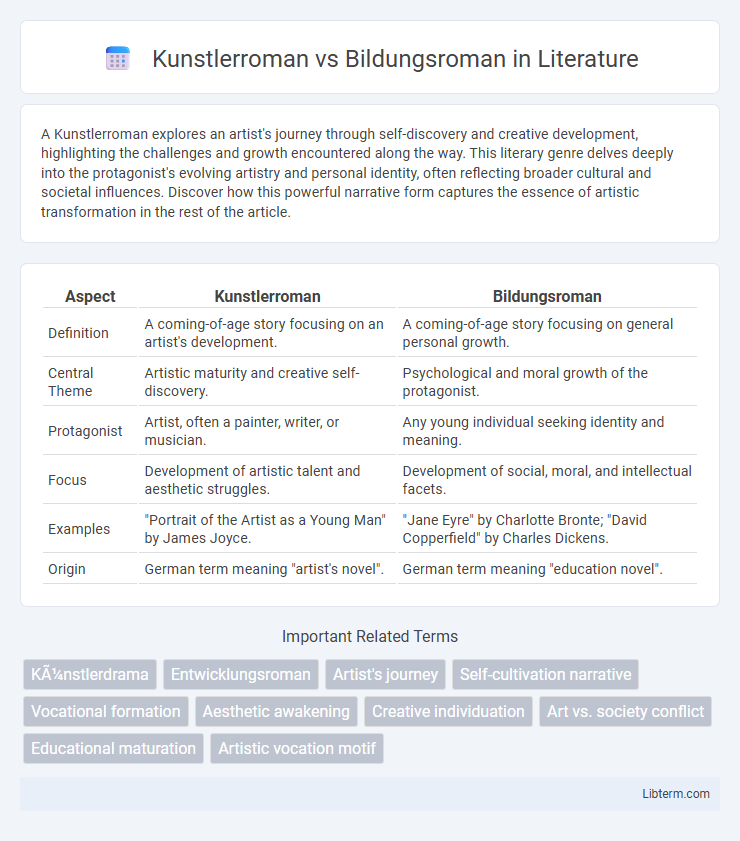A Kunstlerroman explores an artist's journey through self-discovery and creative development, highlighting the challenges and growth encountered along the way. This literary genre delves deeply into the protagonist's evolving artistry and personal identity, often reflecting broader cultural and societal influences. Discover how this powerful narrative form captures the essence of artistic transformation in the rest of the article.
Table of Comparison
| Aspect | Kunstlerroman | Bildungsroman |
|---|---|---|
| Definition | A coming-of-age story focusing on an artist's development. | A coming-of-age story focusing on general personal growth. |
| Central Theme | Artistic maturity and creative self-discovery. | Psychological and moral growth of the protagonist. |
| Protagonist | Artist, often a painter, writer, or musician. | Any young individual seeking identity and meaning. |
| Focus | Development of artistic talent and aesthetic struggles. | Development of social, moral, and intellectual facets. |
| Examples | "Portrait of the Artist as a Young Man" by James Joyce. | "Jane Eyre" by Charlotte Bronte; "David Copperfield" by Charles Dickens. |
| Origin | German term meaning "artist's novel". | German term meaning "education novel". |
Introduction to the Kunstlerroman and Bildungsroman
Kunstlerroman and Bildungsroman are distinct literary genres focusing on personal development, with the Kunstlerroman specifically depicting an artist's growth, struggles, and creative awakening. Bildungsroman traces a protagonist's psychological and moral growth from youth to adulthood, highlighting formative life experiences shaping character and worldview. Both genres explore identity formation but differ in thematic emphasis--artistic development in Kunstlerroman versus broader maturation in Bildungsroman.
Defining the Bildungsroman: Origins and Characteristics
The Bildungsroman, originating in late 18th-century Germany with Goethe's "Wilhelm Meister's Apprenticeship," centers on the psychological and moral growth of the protagonist from youth to adulthood. Characterized by a journey of self-discovery and personal development, it emphasizes maturation through social integration and the resolution of internal conflicts. Unlike the Kunstlerroman, which specifically focuses on the development of an artist, the Bildungsroman addresses broader themes of identity formation and societal assimilation.
Unpacking the Kunstlerroman: Meaning and Evolution
The Kunstlerroman, a distinct sub-genre of the Bildungsroman, centers on the development of an artist's creative identity, tracing the protagonist's journey toward artistic maturity. Unlike the Bildungsroman, which explores broader personal growth, the Kunstlerroman emphasizes the struggle to reconcile artistic ambition with societal pressures and self-expression. Over time, this genre evolved from early Romantic fiction to contemporary narratives, reflecting changing cultural attitudes toward art and individual creativity.
Historical Contexts: Rise of the Two Genres
The Bildungsroman emerged in late 18th-century Germany, reflecting the Enlightenment's focus on individual development and moral education during societal shifts. The Kunstlerroman, a specialized subset, gained prominence in the 19th century as Romanticism emphasized artistic genius and creative struggles amid industrialization and cultural transformation. Both genres illustrate evolving historical contexts of personal and artistic identity in response to changing social values and intellectual movements.
Key Themes: Identity, Growth, and Artistic Development
Kunstlerroman centers on the protagonist's artistic growth and creative identity, emphasizing the challenges and transformations specific to the artist's journey. Bildungsroman broadly explores personal development and self-discovery, highlighting social integration and moral maturation as key themes. Both genres deeply investigate identity and growth but diverge by focusing on artistic evolution in Kunstlerroman and general psychological and social development in Bildungsroman.
Structural Differences Between Kunstlerroman and Bildungsroman
Kunstlerroman centers on the protagonist's development as an artist, highlighting the internal conflict between individual creativity and societal expectations, while Bildungsroman emphasizes the broader psychological and moral growth leading to social integration. Structurally, Kunstlerroman often includes episodes of artistic struggle and moments of self-expression pivotal to the character's identity, whereas Bildungsroman follows a more linear progression from youth to maturity, focusing on experiences that shape the protagonist's worldview. The narrative in Kunstlerroman is episodic, concentrating on artistic development stages, whereas Bildungsroman maintains a cohesive trajectory toward social conformity and personal enlightenment.
Iconic Examples in Literature
Kunstlerroman and Bildungsroman are two related literary genres focusing on personal development, with the Kunstlerroman specifically centering on the growth of an artist. Iconic examples of the Kunstlerroman include James Joyce's *A Portrait of the Artist as a Young Man*, which explores the protagonist's maturation as a writer, and Thomas Mann's *Tonio Kroger*, depicting the struggles of an aspiring artist. In contrast, Bildungsroman such as Goethe's *Wilhelm Meister's Apprenticeship* emphasize broader personal and moral development beyond artistic vocation.
The Role of Society and Environment in Both Genres
Kunstlerroman and Bildungsroman both explore individual development influenced by society and environment, yet Kunstlerroman emphasizes the artist's struggle against societal norms to achieve creative identity. Bildungsroman centers on a protagonist's moral and psychological growth, highlighting how social institutions and cultural expectations shape their integration into society. In Kunstlerroman, external conflicts often reflect the tension between personal artistic vision and societal constraints, while Bildungsroman portrays a more harmonious adaptation to social values.
Evolution of Genre Boundaries in Modern Literature
Kunstlerroman and Bildungsroman both explore personal development but differ in focus--Kunstlerroman centers on the artist's creative growth, while Bildungsroman traces general psychological and moral maturation. The evolution of genre boundaries in modern literature blurs these distinctions, integrating artistic identity with broader coming-of-age themes to reflect complex individual experiences. Contemporary works increasingly hybridize elements from both genres, challenging traditional classifications and expanding narrative possibilities.
Conclusion: Lasting Impact on Literary Traditions
Kunstlerroman and Bildungsroman both explore individual growth but focus on different aspects: artistic development versus general personal maturation. Kunstlerroman's emphasis on the creative process has enriched literary traditions by deepening narratives about artistic identity and vocational struggles. Bildungsroman's broad portrayal of psychological and social growth continues to influence storytelling by framing human experience through developmental milestones.
Kunstlerroman Infographic

 libterm.com
libterm.com